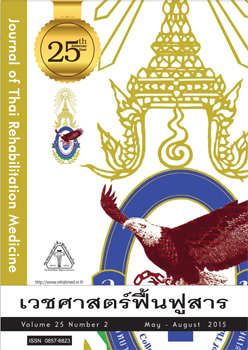รูปแบบการเรียนแบบสหวิชาชีพ ณ กลุ่มงานเวชกรรมฟื้นฟู โรงพยาบาลอุดรธานี
Keywords:
การเรียนแบบสหวิชาชีพ, เวชศาสตร์ฟื้นฟู, Interprofessional education, Rehabilitation MedicineAbstract
A Model of Interprofessional Education (IPE) in Department of Physical Medicine and Rehabilitation, Udonthani Hospital
Sethasathien S
Department of Physical Medicine and Rehabilitation,Udonthani Hospital, Udonthani.
Objective: To develop an interprofessional education (IPE) model for under graduated students at Department of Physical Medicine and Rehabilitation, Udonthani hospital.
Study Design: Innovation in medical education
Setting: Department of Physical Medicine and Rehabilitation, Udonthani Hospital
Subjects: Fourth-year medical, physiotherapy, occupational therapy and nursing students who studied concurrently at Department of Physical Medicine and Rehabilitation, Udonthani Hospital during March 2012 –November 2013.
Methods: Workplace based IPE was conducted for the fourth-year medical ,physiotherapy, occupational therapy and nursing students from different universities when they studied concurrently at Department of Physical Medicine and Rehabilitation. Groups of six to eight mixed students and one facilitator worked collaboratively with stroke patients during rehabilitation phase. Patient’s data gathering, physical examination, problem list, rehabilitation goal and plan of treatment were done in group, following by presentation and panel discussion. Students’ satisfaction was evaluated by self-assessment questionnaires and students’ performance were observed. Problems and suggestions were collected to improve the consecutive IPE session.
Results: 86 mixed students were included in four IPE sessions. No students had IPE experience but 97.6% expressed their readiness for IPE, lower number was found in nursing students. Of all, 95.3% strongly agreed that IPE increased understanding in interprofessional role, 68.6% strongly agreed that IPE increased their professional knowledge, 79.1% agreed that duration of the session was enough for IPE activities, 88.4% strongly agreed to use IPE in other Rehabilitation Medicine topics, and 89.5% could play proper role during session. Overall satisfaction scores raised up when short lecture was added at the end and multi-professional facilitators were included. .Attending staffs and workers reported no extra workload.
Conclusion: Workplace-based IPE with multi-professional facilitators in combination with short lectured-based learning was a satisfied IPE model for rehabilitation students at Udonthani Hospital. Medical students required more professional knowledge and nursing students required more self confidence for active participation.
บทคัดย่อ
วัตถุประสงค์: สร้างรูปแบบการเรียนแบบสหวิชาชีพสำหรับนักศึกษาระดับก่อนปริญญา ของกลุ่มงานเวชกรรมฟื้นฟู โรงพยาบาลอุดรธานี
รูปแบบการวิจัย: นวัตกรรมด้านแพทยศาสตร์ศึกษา
สถานที่ทำการวิจัย: กลุ่มงานเวชกรรมฟื้นฟู โรงพยาบาลอุดรธานี
กลุ่มประชากร: นักศึกษาชั้นปีที่ 4 สาขาแพทยศาสตร์ กายภาพบำบัด กิจกรรมบำบัด และพยาบาลศาสตร์จากมหาวิทยาลัยต่าง ๆ ที่มาฝึกปฏิบัติงานที่กลุ่มงานเวชกรรมฟื้นฟู ระหว่างเดือนมีนาคม พ.ศ. 2555 - พฤศจิกายน พ.ศ. 2556
วิธีการศึกษา: แบ่งนักศึกษาเป็นกลุ่มย่อยกลุ่มละ 6-8 คน แบบคละวิชาชีพ และมอบหมายให้ร่วมกันศึกษาผู้ป่วยอัมพาตครึ่งซีกจากโรคหลอดเลือดสมองในระยะฟื้นฟู โดยช่วยกันรวบรวมประวัติ ตรวจประเมิน วางเป้าหมายและแผนการรักษาฟื้นฟู โดยมีอาจารย์ร่วมสอนเป็นผู้สังเกตการณ์ประจำกลุ่ม หลังจากนั้นให้ตัวแทนกลุ่มนำเสนอรายงานหน้าชั้นเรียนและนักศึกษาในชั้นเรียนร่วมกันอภิปรายแล้วอาจารย์ผู้สังเกตการณ์ให้ข้อมูลสะท้อนกลับในด้านกระบวนการกลุ่ม และทักษะการปฏิสัมพันธ์ของนักศึกษา ประเมินความพึงพอใจของนักศึกษาต่อรูปแบบการเรียนโดยใช้แบบสอบถามชนิดตอบด้วยตนเอง ประเมิน พฤติกรรมระหว่างการเรียนโดยการสังเกตการณ์ของอาจารย์ร่วมสอน และประเมินความคิดเห็นของอาจารย์โดยการสัมภาษณ์ผู้ศึกษานำข้อเสนอแนะจากผู้เรียนและอาจารย์ไปปรับปรุงการจัดการเรียนแบบสหวิชาชีพในครั้งต่อมา
ผลการศึกษา: ได้จัดการเรียนแบบสหวิชาชีพรวม 4 ครั้ง นักศึกษาสหวิชาชีพรวม 86 คน ไม่มีนักศึกษาที่มีประสบการณ์การเรียนแบบสหวิชาชีพมาก่อน, ร้อยละ 97.6 เห็นว่ามีความ พร้อมต่อการเรียนโดยที่กลุ่มนักศึกษาพยาบาลให้คะแนนความ พร้อมของตนเองในการเรียนแบบสหวิชาชีพต่ำกว่าสาขาอื่น, ร้อยละ 95.3 เห็นด้วยเป็นอย่างยิ่งว่าเป็นวิธีการเรียนที่ช่วยให้เข้าใจบทบาทของแต่ละวิชาชีพและลักษณะการทำงานร่วมกันมากขึ้น, ร้อยละ 68.6 เห็นด้วยอย่างยิ่งว่าช่วยเพิ่มความรู้ในวิชาชีพ, ร้อยละ 79.1 เห็นด้วยอย่างยิ่งว่าระยะเวลาในการจัดกิจกรรมเหมาะสม นักศึกษาทุกคนเห็นด้วยว่าควรจัดให้มีการ เรียนการสอนวิธีนี้ต่อไป อาจารย์ผู้สังเกตการณ์เห็นว่า ร้อยละ 89.5 ของนักศึกษาแสดงการมีส่วนร่วมอย่างเหมาะสมแล้ว จากการปรับปรุงการจัดการเรียนตามข้อแนะนำในครั้งต่อ ๆ มาพบว่า คะแนนความพึงพอใจของนักศึกษาเพิ่มสูงขึ้นเมื่อผู้สอนมีการสรุปสาระสำคัญของเนื้อหาหลังการอภิปรายกลุ่ม และมีอาจารย์สหวิชาชีพร่วมกิจกรรมด้วย ทั้งนี้อาจารย์ร่วมสอน และผู้ปฏิบัติงานไม่รู้สึกว่าวิธีการเรียนนี้ทำให้ภาระงานเพิ่มขึ้น
สรุป: การเรียนแบบสหวิชาชีพในสถานที่ฝึกปฏิบัติงาน โดยมีการสรุปสาระสำคัญของเนื้อหาโดยอาจารย์ผู้สอนเมื่อสิ้นสุดการอภิปรายกลุ่มและมีอาจารย์สหวิชาชีพร่วมกิจกรรมด้วยเป็นรูปแบบการเรียนแบบสหวิชาชีพที่นักศึกษาของกลุ่มงานเวช-กรรมฟื้นฟู โรงพยาบาลอุดรธานีพึงพอใจ และในการเรียนวิธีนี้ นักศึกษาแพทย์ชั้นปีที่4ต้องเตรียมความรู้จำเพาะในวิชาชีพให้พร้อมมากขึ้น และควรเสริมความมั่นใจในการร่วมกิจกรรมกลุ่มให้แก่นักศึกษาพยาบาล






